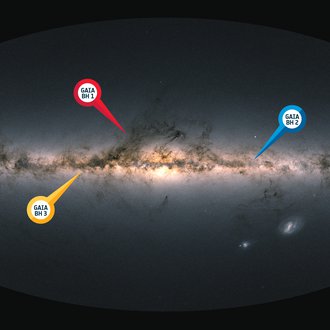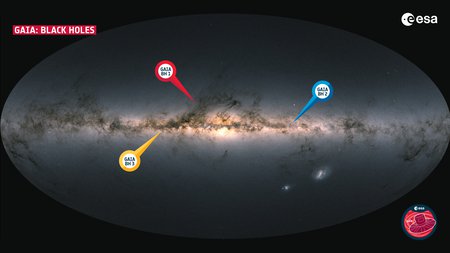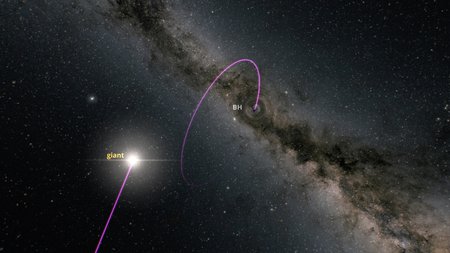Gaia discovers large dormant black hole in our galaxy

This sky map shows Gaia’s three black holes at their respective locations on the sky.
Credit: ESA/Gaia/DPACWhile validating the data from ESA's Gaia mission, scientists uncovered a ‘sleeping’ giant. A large black hole, with a mass of nearly 33 times the mass of the Sun, was hiding in the constellation Aquila, less than 2000 light-years from Earth. This is the first time a black hole of stellar origin this big has been spotted so close to home. The discovery challenges our understanding of how massive stars develop and evolve.
Matter in a black hole is so densely packed that nothing can escape its immense gravitational pull, not even light. The great majority of stellar-mass black holes that we know of are gobbling up matter from a nearby star companion. The captured material falls onto the collapsed object at high speed, becoming extremely hot and releasing X-rays. These systems belong to a family of celestial objects named X-ray binaries. When a black hole does not have a companion close enough to steal matter from, it does not generate any light and is extremely difficult to spot. These black holes are called ‘dormant’.
To prepare for the release of the next Gaia catalogue, Data Release 4 (DR4), scientists are checking the motions of billions of stars and carrying out complex tests to see if anything is out of the ordinary. The motions of stars can be affected by companions: light ones, like exoplanets; heavier ones, like stars; or very heavy ones, like black holes. Dedicated teams are in place in the Gaia Collaboration to investigate any ‘odd’ cases.
One such team was deeply engaged in this work, when their attention fell on an old giant star in the constellation Aquila, at a distance of 1926 light-years from Earth. By analysing in detail the wobble in the star’s path, they found a big surprise. The star was locked in an orbital motion with a dormant black hole of exceptionally high mass, about 33 times that of the Sun.
This is the third dormant black hole found with Gaia and was aptly named ‘Gaia BH3’. Its discovery is very exciting because of the mass of the object. “It's a real unicorn,” exclaims Pasquale Panuzzo of CNRS, Observatoire de Paris, in France, who is the lead author of this finding. “This is the kind of discovery you make once in your research life. So far, black holes this big have only ever been detected in distant galaxies, by the LIGO–Virgo–KAGRA collaboration thanks to observations of gravitational waves.”
The average mass of known black holes of stellar origin in our galaxy is around 10 times the mass of our Sun. Until now, the weight record was held by a black hole in an X-ray binary in the Cygnus constellation (Cyg X-1), whose mass is estimated to be around 20 times that of the Sun.
The Gaia data allowed scientists to accurately determine the mass of black hole Gaia BH3, establishing it as the first black hole with such precise mass measurement. At 30 times the mass of the Sun, it aligns with estimates from distant black holes detected via gravitational waves, confirming the existence of such heavy black holes. However, the origin of such massive black holes poses a challenge to current understanding, as conventional theories of massive star evolution struggle to explain their formation. Despite this, clues to this mystery may be found in the vicinity of Gaia BH3.
An unusual star orbits Gaia BH3 at a distance of about 16 times that of the Sun to Earth, dating back to the early stages of the galaxy's formation. Belonging to the Galactic stellar halo, it moves counter to the stars in the Galactic disc, indicating it likely originated from a small galaxy or globular cluster swallowed by our own galaxy over eight billion years ago. The companion star's elemental composition, lacking heavy elements, supports the theory that Gaia BH3 formed from the collapse of ancient, metal-poor massive stars. This composition also suggests the binary system formed after Gaia BH3's birth, possibly through capturing the companion star from another system.
The Gaia collaboration stumbled upon this ‘sleeping’ giant while inspecting the correctness of preliminary data in preparation for the fourth release of the Gaia catalogue. Because the finding is so exceptional they decided to announce it ahead of the official release. The next release of Gaia data promises to be a goldmine for the study of binary systems and the discovery of more dormant black holes in our galaxy.
The Leibniz Institute for Astrophysics Potsdam (AIP) is part of the Gaia collaboration that prepares all Gaia data for publication and as such involved in this exciting discovery.
Further information
More about Gaia (ESA): https://www.cosmos.esa.int/web/gaia
ESA press release: https://www.esa.int/Science_Exploration/Space_Science/Gaia/Sleeping_giant_surprises_Gaia_scientists
Scientific publication: Gaia Collaboration, P. Panuzzo et al. 2023: “Discovery of a dormant 33 solar-mass black hole in pre-release Gaia astrometry”, https://www.aanda.org/10.1051/0004-6361/202449763
Images
This sky map shows Gaia’s three black holes at their respective locations on the sky.
Big screen size [1000 x 562, 60 KB]
Original size [8000 x 4500, 9.4 MB]
The black hole was discovered via the orbit of its giant companion star. The 33 solar-mass black hole is one of the most massive black holes of stellar origin found to date and with about 1900 light-years distance the second closest black hole to Earth.
Extract from the video.
Big screen size [1000 x 562, 90 KB]
Original size [5068 x 2850, 1.4 MB]




